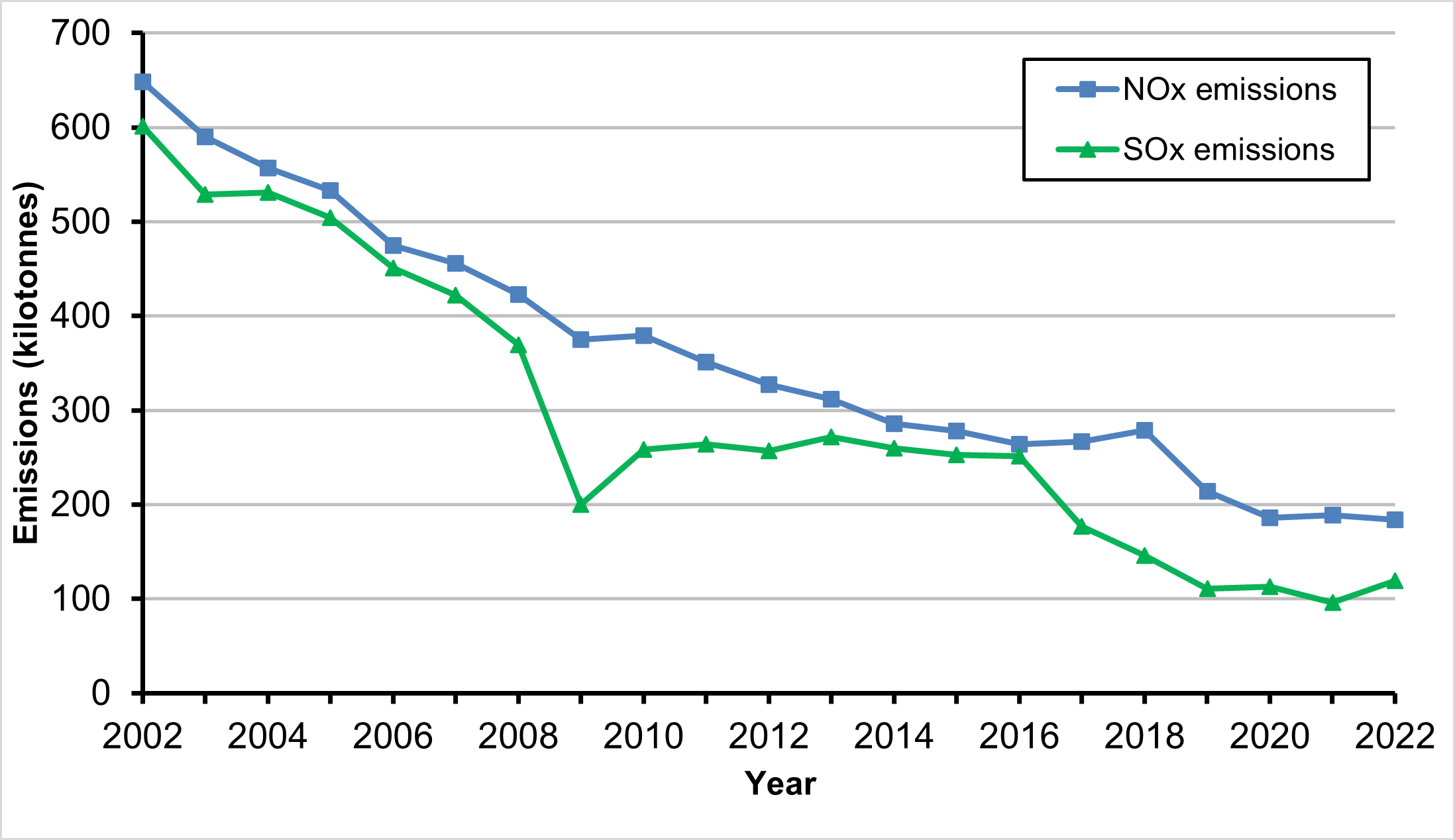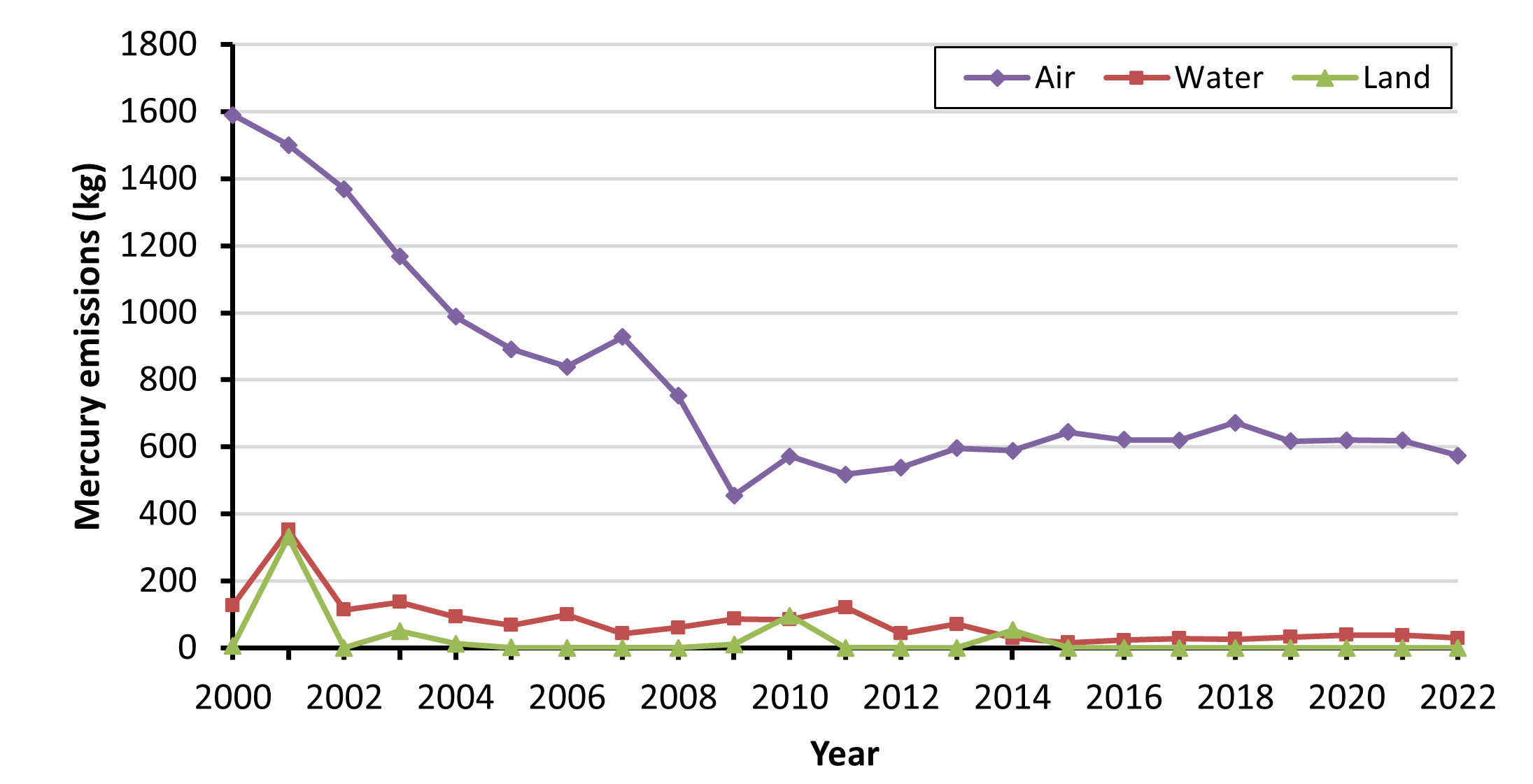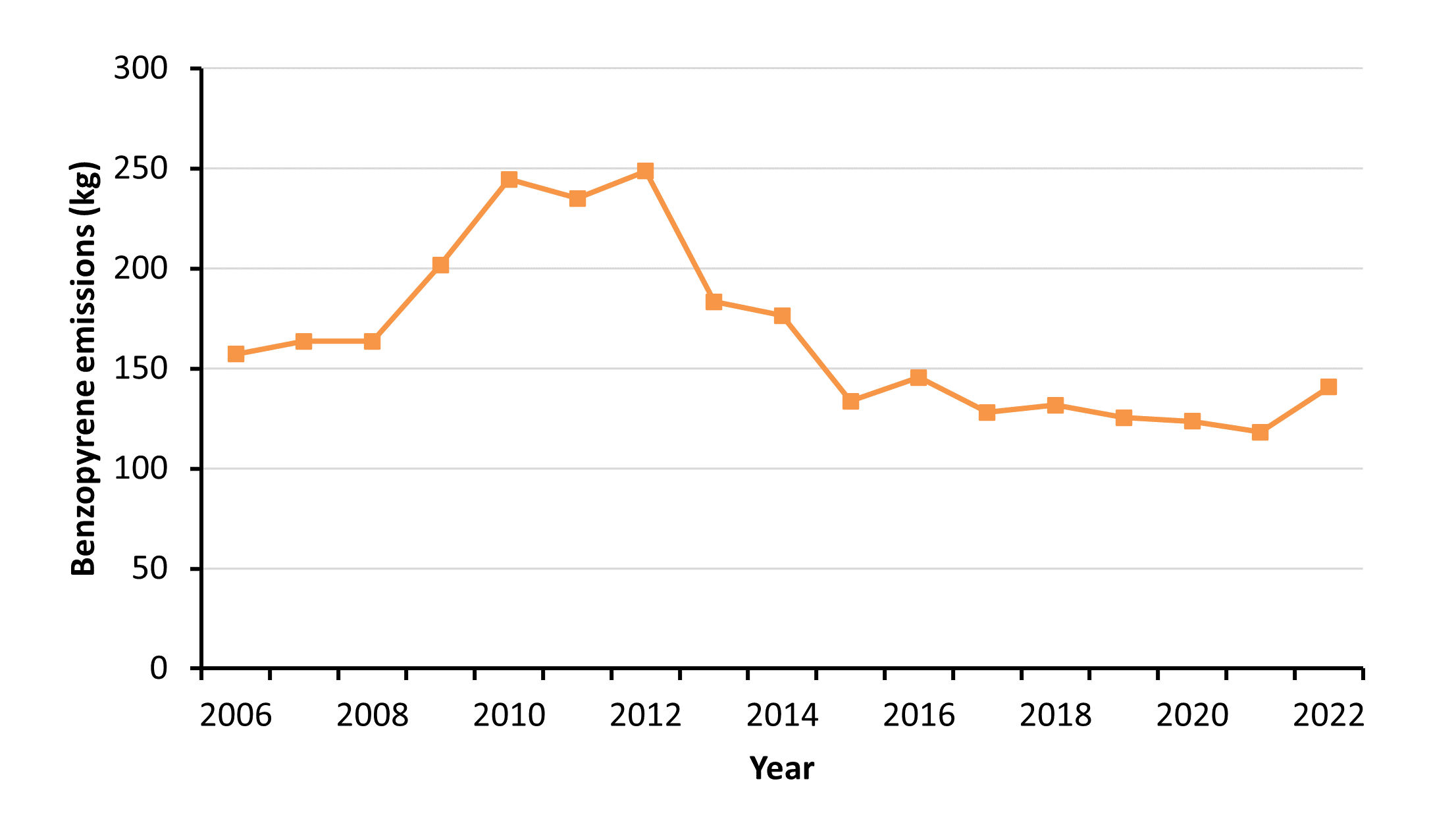
Figure 1. Nitrogen oxide (NOx) and sulphur oxide (SOx) emissions in Ontario 2002-2022. Note: Emissions from natural sources and open sources are not included (Source APEI).
 Figure 2. Mercury (elemental, inorganic) emissions in Ontario 2000-2022 (Source APEI).
Figure 2. Mercury (elemental, inorganic) emissions in Ontario 2000-2022 (Source APEI).

Figure 3. Total benzopyrene emissions in air, water and land in Ontario 2006-2022 (Source NPRI)
Status
- Between 2002 and 2022 nitrogen oxide (NOx) emissions in Ontario decreased by 72%, dropping consistently to 2014 and remaining relatively stable from 2014-2022. The decline can be attributed to emissions regulations for industry as well as the phase-in of new vehicles having more stringent emission standards.
- Between 2002 and 2022 sulphur oxide (SOx) emissions in Ontario decreased by 80%. These reductions were largely due to reductions in emissions from fossil-fuel (e.g. coal) fired power-generating utilities, plant closures, as well as a reduction in emissions from the petroleum refining sector. The recent decline in SOx emissions between 2016 and 2022 reflects major renovation work as part of SO2 emission reduction projects at two of the largest smelters in the province.
- Between 2000 and 2022 mercury emissions in Ontario decreased by 65%, mainly due to the closing of coal fired power plants and a reduction of emissions from waste disposal and industrial sources. Most of the decline occurred between 2000-2010 and has remained relatively stable from 2010-2022.
- Between 2006 and 2022 benzopyrene emissions in Ontario decreased by 10%, mainly due to the closing of coal fired power plants and a reduction of emissions from waste disposal and industrial sources and vehicle emissions.
Previous versions
The release of pollutants into the air and water and onto the land can have significant effects on biodiversity. Pollutants can kill organisms outright, accumulate in food chains and impact human health. They can change the conditions and processes occurring within an ecosystem, and result in broad changes that degrade habitats and ecosystem services. Biodiversity associated with areas used intensively by humans (e.g., urban areas, agriculture, forestry, mining, and other industries) may be most at risk from pollution; however, non-point-based effects of pollution on biodiversity (e.g., downstream water pollution and downwind air pollution) can also be significant. Currently, a wide range of pollutants interact with natural and other human created factors to alter ecosystems and impact Ontario’s biodiversity. Four pollutants in particular — nitrogen oxides (NOx), sulphur oxides (SOx), mercury and benzopyrene, have all been shown to impact biodiversity in Ontario and were used in this indicator as an index to examine trends in the release of pollutants harmful to biodiversity.
Nitrogen and sulphur oxides are two of the most common air pollutants produced as a result of human activities. They are primarily released as a result of the combustion process. In Ontario, the biggest contributor to NOx emissions is the transportation sector, while the major sources of SOx emissions are from smelters, industrial processes and electric utilities. When emitted into the atmosphere these gases can be transformed into acidic particles or, when they react with water, into acid rain (Driscoll et al., 2001). The effects of nitrogen and sulphur oxides on the environment are generally not caused by direct exposure to the gases themselves but are related to chronic accumulation in plants and soils and long-term changes in soil and water chemistry (Lovett et al. 2009). Nitrogen and sulphur oxides in the air can damage the leaves of plants, decrease their ability to produce food (photosynthesis) and decrease their growth. In addition, when deposited on land and in estuaries, lakes and streams, nitrogen and sulphur oxides can acidify and over-fertilize sensitive ecosystems resulting in a range of harmful deposition-related effects on plants, soils, water quality and fish and wildlife (e.g., loss of habitat, reduced tree growth, loss of fish species, and harmful algal blooms) (Lee 1998; Bobbink and Lamers 2020). This can result in an overall loss of biodiversity and subsequent reduction in ecosystem services (e.g., water and soil quality) (Aherne and Posch 2013). These impacts are likely to occur where the accumulation of nitrogen and sulphur crosses a threshold known as the critical load. For more than a decade, Canada has worked to reduce nitrogen and sulphur oxides by implementing the Canada-wide Acid Rain Strategy for Post-2000.
Mercury is a highly toxic element released primarily from coal combustion, waste incineration and industrial processes (Lovett et al. 2009). Mercury, primarily methylmercury, is quickly accumulated by aquatic species and causes adverse effects. Biomagnification of mercury up the food chain has been shown, especially in aquatic systems where predators at the top of the food chain accumulate the highest concentrations of mercury (Lovett et al. 2009). There has been increasing recognition that mercury affects fish and wildlife health in ecosystems both severely and moderately polluted with mercury. Studies have documented diminished reproductive success, behavioural changes and reduced survival of fish, fish-eating birds and mammals due to mercury contamination in aquatic ecosystems (Scheuhammer et al. 2007). There has been effort to reduce the amount of mercury released into the environment. In 2017, Canada ratified and brought into force the Minamata Convention on Mercury, a global treaty to protect both human health and the environment from the adverse effects of mercury.
Benzopyrene is an organic compound that threatens biodiversity due to its toxic nature, it is part of a class of chemicals called polycyclic aromatic hydrocarbons (PAH). PAHs occur naturally in coal, crude oil and gasoline and result from burning coal, oil, gas, wood and tobacco (CDC 2022). Benzopyrene readily enters ecosystems through air and water (Bukowska et al. 2022). Once absorbed, it accumulates in soil and sediment, persisting for long periods and bioaccumulating in organisms throughout the food chain. It has been linked to adversely effect both terrestrial and aquatic organisms — disrupting reproductive systems; causing genetic mutations; and impairing immune function. Benzopyrene has the ability to adhere to airborne particles allowing for them to be transported long distances, affecting ecosystems far from the original source. Canada has recognized the threat benzopyrene poses to biodiversity and has implemented regulations under the Canadian Environmental Protection Act (CEPA) to set emission limits for various pollutants, including PAHs, from industrial facilities.
This indicator assesses trends in the release of nitrogen oxides, sulphur oxides, mercury and benzopyrene in Ontario as an index of trends in the release of pollutants harmful to biodiversity in Ontario.
Related Theme(s)
Related Target(s)
Web Links:
Related Targets: N/A
Related Themes: N/A
References:
Aherne, J., and M. Posch. 2013. Impacts of nitrogen and sulphur deposition on forest ecosystem services in Canada. Current Opinion in Environmental Sustainability 5:108-115.
Bobbink, R., and L.P.M. Lamers. 2002. Effects of increased nitrogen deposition. In: Bell, J.N.D., and M. Treshow (eds). Air pollution and plant life, 2nd edition. John Wiley and Sons Ltd, Chichester, U.K.
Bukowska, B., Mokra, K., & Michałowicz, J. 2022. Benzo [a] pyrene—environmental occurrence, human exposure, and mechanisms of toxicity. International Journal of Molecular Sciences, 23(11), 6348.
Driscoll, C.T., G.B. Lawrence, A.J. Bulger, T.J. Butler, C.S. Cronan, C. Eagar, K.F. Lambert, G.E. Likens, J.L. Stoddard, and K.C. Weathers. 2001. Acidic deposition in the northeastern United States: sources and inputs, ecosystem effects, and management strategies. BioScience 51:180-198.
Environment and Climate Change Canada. 2018. Canadian Environmental Sustainability Indicators. [Available at: https://www.ec.gc.ca/indicateurs-indicators/default.asp?lang=En]
Lee, J.A. 1998. Unintentional experiments with terrestrial ecosystems: ecological effects of sulphur and nitrogen pollutants. Journal of Ecology 86:1–12.
Lovett, G.M., T.H. Tear, D.C. Evers, S.E.G. Findlay, B.J. Cosby, J.K. Dunscomb, C.T, Driscoll, and K.C. Weathers. 2009. Effects of air pollution on ecosystems and biological diversity in the eastern United States. BioScience 1162:99-135.
Scheuhammer, A.M., M.W. Meyer, M.B. Sandheinrich, and M.W. Murray. 2007. Effects of environmental methylmercury on the health of wild birds, mammals, and fish. AMBIO: A Journal of the Human Environment 36: 12-16.
Human activities caused emissions of sulphur and nitrogen to increase dramatically in the middle of the twentieth century (Driscoll et al. 2001). Control programs have reduced emissions but sulphur and nitrogen compounds are expected to have continuing negative impacts on biodiversity. In particular, sulphur and nitrogen compounds in the form of acid rain can cause acidification of soils and surface waters and can decrease soil nutrients to inadequate levels for plant growth. In addition, excess…
Read More
 Figure 2. Mercury (elemental, inorganic) emissions in Ontario 2000-2022 (Source APEI).
Figure 2. Mercury (elemental, inorganic) emissions in Ontario 2000-2022 (Source APEI).

